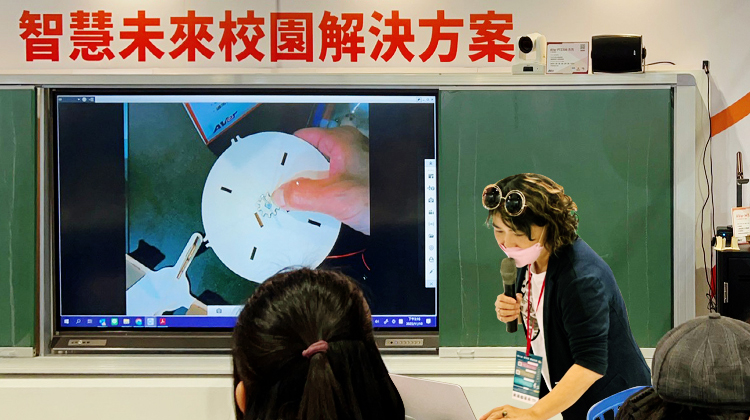Picking the right technology for your classroom is a challenge. With technology developing so quickly year by year, the choices are endless, making it very difficult to choose and learn how to use these products. We are here today at the Taipei RenAi Maker Education and Technology Center (TRMETC) with a teacher whose students boast of bringing in multiple awards yearly while maintaining unbelievable academic achievement. We are very honored to be interviewing Director Li Mei-Huei, who will share her rich teaching experience utilizing technology to maximize learning outcomes and create great students.
Q: What is RenAi Junior High School’s goal when utilizing education technology in schools?
The 108 Curriculum Guidelines emphasize the importance of technology for both educators and students, so we stress the importance of fostering our students' abilities in logic, design, and creativity. With this in mind, the Taipei RenAi Maker Education and Technology Center (TRMETC) works towards two major goals. The first goal is to incorporate edtech into the arsenal of teachers so that schools can bring rich, stimulating learning experiences to students. The second goal is to let students experience a variety of different technologies, including information technologies, emerging technologies, and everyday technologies. We allow students to experience technology through a range of extracurricular courses and activities, sometimes even incorporating new technologies into everyday school curriculums.
Q: How did the teachers at RenAi, a public school, grow to use so much technology and incorporate technological products to support teaching?

Many teachers began learning about edtech products during the COVID pandemic since many teachers needed tools for distance learning during this time. As we went from seeing students face-to-face to seeing them onscreen, we can only imagine how difficult it was for students to keep their focus on the lessons. It was up to the teachers to come up with enticing lessons that would keep their attention—many times through optimizing their lessons by making them as interesting as possible.
One of the major tools we used were distance learning cameras and visualizers. They captured great videos and images of classes, and whatever scene we captured on camera, we’d be able to annotate it digitally, and I believe AVer’s CaptureShare to be one of the best software for digital annotation due to its reliability, responsiveness, and flexibility. Through the software, we can demonstrate what to do during a lab experiment through the camera or highlight a paragraph in a textbook by making annotations onscreen to emphasize major concepts. This made it possible for teaching to continue throughout the pandemic.
Q: Are there any pain points in the classroom currently encountered by teachers?
There are plenty! Continuing the topic of the pandemic, some students were more capable of adapting to remote teaching than others, and this caused a gap in knowledge among the students who came back to school after the pandemic ended. The students who were less equipped for remote learning were simply unable to learn in the remote learning environment for two entire years, perhaps because the classes weren’t stimulating enough for them compared to having class face-to-face, and that is still an issue we are dealing with right now.

Compounding the issue, there is also a significant discrepancy in the digital skills of students. Many students are digital natives, many of whom have known digital technologies nearly their entire lives. Those who are less digitally adept may have fewer resources at home and others may have parents who do not allow their children to access digital devices because they find it unnecessary for their child to do so at such a young age. Though, understandably, parents may be concerned about their children’s digital well-being, I still find it surprising that some middle school students have a hard time logging into their accounts on the educational platforms we use. When the digital skills of students vary so intensely, it is impossible for a teacher to create a one-size-fits-all lesson. This is when peer learning is particularly important: dividing students into groups with varying skill sets can make a vast difference in learning retention. Students who know the material can review and find creative ways to teach their peers how a concept works, and those who need help get the one-on-one help they need.
While still on the topic of the digital divide, there is also a difference in digital skills between students and teachers as well. Most teachers right now are digital immigrants, so dealing with students who are digital natives is for sure a challenge. Facing these students means that teachers must put in effort to keep up with technology, including new technologies like generative AI. To deal with this pressure, teachers themselves need to be able to work as a team, like how we teach our students. We work together by dividing up work according to each teacher’s expertise or interest. For example, Teacher A may be well-versed in the world of AI technology, so perhaps it would be a good idea for that teacher to create a presentation on the topic for all the teachers to use in their courses, and teachers can simply tweak the teaching materials to suit their class before teaching. By sharing teaching materials, we share the dreadful burden of learning everything at once, but when sharing the load, we can accomplish a lot more.
Last but not least, there is the issue of resources. The limited amount of resources schools have is undoubtedly a pain point for most schools. Oftentimes when schools receive funding, it goes to the most pressing matter, and usually, that won’t be edtech. When schools do have the funding to purchase digital hardware, they may not have the digital infrastructure, such as the Internet, to support the use of the hardware. When schools acquire internet and hardware, they still have to worry about the funding for the software, the maintenance and repair fees, and other supporting products and services. For most schools, the funding almost never covers the last portion mentioned, but oftentimes the last portion is what determines if a school is able to continue the use of education technologies.
In 2021, the Taiwan government prepared NT$20 billion with the sole purpose of improving digital learning, and it aims to address the earlier steps of this problem. At the very least, students will be able to have access to the internet and have access to tablets. The plan also prioritizes schools in rural areas, granting each student in rural schools one tablet while offering one tablet for every six students in urban areas. With the basics taken care of, schools will then have more funding to cover software and maintenance, which is a step in the right direction. We would really love to see more students finding their passions and excelling in their interests by having the right learning tools.
So far, we saw how teachers became aware of the important role of technology in teaching and the pressures teachers face in the classroom. In the next article in this series, we’ll hear Director Li discussing the best tools she has to liven up her classroom and various creative ways to use technology to support student learning.